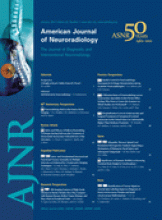Abstract
BACKGROUND AND PURPOSE: Chronic cerebrospinal venous insufficiency (CCSVI) is a vascular condition characterized by anomalies of the main extracranial cerebrospinal venous routes that interfere with normal venous outflow. Research into CCSVI will determine its sensitivity and specificity for a diagnosis of MS, its prevalence in MS patients, and its clinical, MRI, and genetic correlates. Our aim was to investigate the prevalence and number of intra- and extraluminal structural and functional extracranial venous abnormalities by using DS and MRV, in patients with MS and HCs.
MATERIALS AND METHODS: One hundred fifty patients with MS, 104 (69.3%) with RR and 46 (30.7%) with a progressive MS course, and 63 age- and sex-matched HCs were scanned with 3T MR imaging by using TOF and TRICKS sequences (only patients with MS). All subjects underwent DS examination for intra- and extraluminal structural and functional abnormalities of the IJVs. Absent/pinpoint IJV flow morphology on MRV was considered an abnormal finding. Prominence of collateral extracranial veins was assessed with MRV.
RESULTS: Patients with MS had a significantly higher number of functional (P < .0001), total (P = .001), and intraluminal (P = .005) structural IJV DS abnormalities than HCs. There was a trend for more patients with MS with extraluminal IJV DS abnormalities (P = .023). No significant differences were found on the MRV IJV flow morphology scale between patients with MS and HCs. Patients with progressive MS showed more extraluminal IJV DS abnormalities (P = .01) and more MRV flow abnormalities on TOF (P = .006) and TRICKS (P = .01) than patients with nonprogressive MS. There was a trend for a higher number of collateral veins in patients with MS than in HCs (P = .016).
CONCLUSIONS: DS is more sensitive than MRV in detecting intraluminal structural and functional venous abnormalities in patients with MS compared with HCs, whereas MRV is more sensitive in showing collaterals.
ABBREVIATIONS
- CCSVI
- chronic cerebrospinal venous insufficiency
- CV
- catheter venography
- DS
- Doppler sonography
- EDSS
- Expanded Disability Status Scale
- Gd
- gadolinium
- HC
- healthy control
- ICC
- interclass correlation coefficient
- IJV
- internal jugular vein
- MRV
- MR venography
- PP
- primary-progressive
- RR
- relapsing-remitting
- SP
- secondary-progressive
- TOF
- time-of-flight
- TRICKS
- time-resolved imaging of contrast kinetics
- VV
- vertebral veins
- © 2012 by American Journal of Neuroradiology
Indicates open access to non-subscribers at www.ajnr.org












